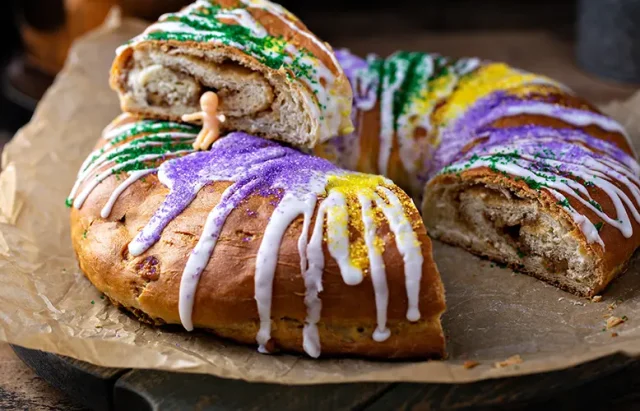
Just as a sumptuous dish whipped up in your favorite ceramic cookware can transport you straight to a far-off location, a single bite of the vibrant ring-shaped king cake can instantly whisk you away to the festive streets of New Orleans.
But did you know this Mardi Gras staple has a passport as colorful as the sugar coating its top? Let’s embark on a delicious journey through time and across continents with the one and only king cake.
The Interesting Origins of the King Cake
The king cake is a traditional French delicacy enjoyed during Epiphany, a Catholic holiday celebrating the three Kings’ visit to the baby Jesus. This great-great-great-grandparent to the modern king cake was a considerably simple dessert, often baked in an oval shape to symbolize unity.
As you can imagine, these cakes weren’t whipped up in today’s fancy cookware. Instead, bakers used traditional wood-burning ovens, carefully monitoring the heat to achieve the just-right golden hue.
Inside each King Cake, bakers hid a “fève,” a porcelain trinket that added a layer of excitement to every slice. These fèves were mini works of art, as small yet intricately detailed as a porcelain tea set.
For centuries, this delightful dessert held a significant place in French society, symbolizing royalty, Christianity, and the joy of shared food. But how did a cake that’s so quintessentially French settle snuggly into the heart of Louisiana’s culture?
From France to New Orleans: Crossing Continents
Throughout the 18th century, the vibrant port city of New Orleans welcomed thousands of French settlers, bringing along their flavorful cuisine and vibrant traditions. Their beloved king cake found a new home here, too.
New Orleans’ king cake wasn’t exactly true to its French origins. The settlers started experimenting by adding a New World twist to the recipe. They infused it with locally available ingredients like sweet potatoes, and over time, the cake morphed from its original oval shape into a more welcoming circular design.
Most notably, the porcelain fève transformed. The trinket evolved into a tiny plastic baby, symbolizing the Christ Child. Tradition dictates that whoever finds the baby in their slice will host the next king cake party, continuing the celebration.
The King Cake slowly entered the city’s traditional Mardi Gras celebration and carved its niche to symbolize camaraderie, zest, and Southern hospitality. Through centuries of evolution and assimilation, this iconic cake, just like New Orleans itself, stands as a vibrant testament to a fusion of diverse cultures, flavors, and traditions.
As Mardi Gras season approaches, you can find this colorful, cinnamon-infused cake in bakeries all over the city, covered in the tri-color sugars of Mardi Gras-purple (for justice), green (for faith), and gold (for power). Let’s appreciate this cake’s journey, from the tables of French royalty to becoming a New Orleans’ cultural cornerstone.
Celebrating the King Cake Today
Today, the King Cake is more than just a cake. It’s an emblem of New Orleans’ culture and Mardi Gras celebration. From the Twelfth Night of January 6 onwards, the city enters “King Cake Season.” It becomes a sight to behold as the crescent city becomes a grand, city-wide King Cake party.
This vibrantly bedecked confection is now more versatile than ever. Bakers across the city create diverse versions that include brioche dough, croissant-like flaky pastries, and even gluten-free variants. Now, King Cake savants can savor unique fillings like cream cheese, praline, and strawberry or even more adventurous ones like crawfish.
Steeped in tradition is the symbolic plastic baby hidden within the cake. If you’re lucky (or unlucky, perhaps?) to find this tiny baby in your slice, you’re on king cake hosting duty next year. This custom keeps the king cake party tradition alive and adds extra fun to each bite.
A Journey Well-Traveled
Just as New Orleans has a way of soaking into your soul, the king cake has an enticing way of embedding itself into your taste buds. Its incredible journey from France to the heart of New Orleans’ Mardi Gras is a testament to the power and influence of food on culture. The king cake is a comforting constant amid the ever-evolving tides of culinary trends.
So, as Mardi Gras season approaches, let’s remember this sweet, doughy, vibrant cake’s grand journey. Perhaps this year, you might be inspired to pick up your ceramic cookware and whip up a king cake version of your own.
Let’s celebrate the unity, diversity, and vibrancy that the king cake symbolizes. After all, we’re all part of this delicious, multi-layered, wildly bejeweled story called life. And what better way could there be to celebrate it than by cutting into a king cake and sharing the joy with friends?





